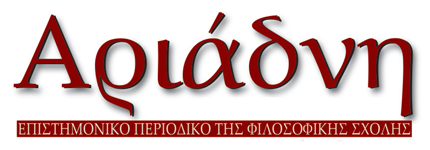Επικούρεια ομολογία πίστης του Γιωργή Ανεμικιώρη: φιλοσοφικό ποίημα του Φρήντριχ Βίλχελμ Γιόζεφ Σέλλινγκ (1799) – εισαγωγή, μετάφραση, σχόλια
DOI:
https://doi.org/10.26248/ariadne.v27i0.1584Περίληψη
SCHELLING wrote Heinz Widerporst’s Epicurean Confession of Faith in the last months of 1799, before turning 25, yet at a crucial stage of his philosophical production. Schelling’s philosophical poem is a materialist and atheist confession of faith and contains a vivid presentation of his Jena philosophy of nature. Schelling’s confession of faith is Epicurean in the popular sense of the term: the affirmation of bodily pleasure.
The introduction discusses the poem’s theoretical and historical context: (a) the intellectual climate of Jena around 1800, of early idealism and early romanticism, (b) the texts that spurred Schelling to write his poem and are the targets of his attack, i.e. Schleiermacher’s On Religion and Novalis’ Christendom or Europe, (c) Schelling’s Jena philosophy of nature, (d) Schelling’s Jena philosophy of art and his ambitious project to compose a “speculative epos”.
Except for the part that presents his philosophy of nature, Schelling did not publish Heinz Widerporst during his lifetime. The Greek translation is not based on the best-known version of the poem. Instead, it is based on a version that Friedrich Schlegel shared with Schleiermacher in a letter. Schlegel apparently elaborated on the poem, and the result is indeed more powerful. The Greek translation preserves the rhyme scheme –rhyming couplets– of Schelling’s Knittelvers. The translator’s notes explicate the references and allusions in Schelling’s poem.
Λήψεις
Δημοσίευση
Πώς να δημιουργήσετε Αναφορές
Τεύχος
Ενότητα
Άδεια
Οι εργασίες που δημοσιεύονται στο περιοδικό μπορούν να χρησιμοποιηθούν ελεύθερα για μη-εμπορικούς σκοπούς με την προϋπόθεση ότι γίνεται αναφορά στους συγγραφείς και την πρώτη δημοσίευση. Στην περίπτωση που το άρθρο αλλοιωθεί, τροποποιηθεί ή δημιουργηθεί κάτι νέο βασισμένο στο αρχικό, το έργο που θα προκύψει θα μπορεί να διανεμηθεί μόνο με την ίδια ή παρόμοια άδεια (Creative Commons Attribution-NonCommercial-ShareAlike 4.0 International License).


